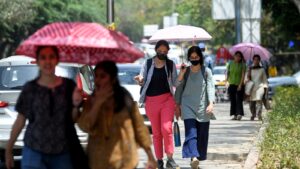J&K polls’ overall turnout figure may fall short of 2014 high

As the voting ended for the final phase on Monday, Jammu and Kashmir witnessed improvement in polling percentage from the recent Lok Sabha polls in the summer. The figure, however, still fell short of the final tally for the 2014 assembly polls.

The voting to the third and final phase of elections in Jammu and Kashmir ended with a polling percentage of 65.6% after witnessing 61.3% in the first and 57.3% in the second on September 18 and 25 respectively.
In contrast, in the recently held Lok Sabha polls, the polling percentage was 58.4% — the highest turnout of the last 35 years in J&K parliamentary elections.
Both overall figures, however, fail to match 2014 when the erstwhile state of Jammu and Kashmir had witnessed a polling percentage of 65.9%. It remains the highest turnout since militancy first erupted in the region in 1989. In 1987, the state had recorded its highest-ever polling percentage of 75%.
“The elections were a resounding statement in favour of democracy,” election commission of India (ECI) reiterated chief election commissioner, Rajiv Kumar’s words after the polls. “The peaceful and participative elections are historic, wherein democracy is taking root more profoundly than ever before, driven by the will of people of Jammu and Kashmir,” he said.
In the third phase, 40 seats went to polling – 24 in Jammu and 16 in Kashmir, after voting completed in 50 seats in the first two phases.
In the Kashmir valley, the 16 seats which went to polling were spread over three districts of North Kashmir — Bandipora , Kupwara and Baramulla falling near the Line of Control (LoC).
In the Valley, the Bandipora district with three assembly seats recorded the highest voting percentage of 64.85%. The number had stood at 74.4% in 2014 assembly polls. Kupwara district with six seats observed 62.7%, down from 71.9% in 2014, polling while Baramulla district with seven seats witnessed 55.7% polling against the 57.7% in 2014.
Only three assembly seats among the 16 in Kashmir could better the 2014 figures. These included Sopore, Baramulla and Pattan constituencies, which recorded 41.4%, 47.9% and 60.8 % voting. In the 2014 assembly polls, two of the three had witnessed a sporadic boycott of elections and recorded 30.8%, 39.7% and 58.7% voting respectively.
To be sure, a seat-by-seat comparison with previous assembly or Lok Sabha polls will mostly be approximate as the boundaries of the constituencies were changed in a delimitation exercise in 2022.
In the four districts of Jammu division, Jammu recorded 66.7% polling, Kathua 70.5%, Samba 72.4% and Udhampur 72.9%.
In the third phase, 415 candidates were in the fray including 387 men and 28 women candidates in this phase of the elections.
The Election Commission of India said the elections have witnessed a significant increase in voter turnout in areas which have been infamous for militancy and boycotting democratic processes.
“Polling percentage has increased by 12.97% in Pulwama assembly constituency (AC) in the phase-I of assembly elections compared to the corresponding elections held in 2014. Zainapora AC in Shopian saw a 9.52% increase while Eidgah AC in Srinagar in phase-II registered a 9.16% increase, reflecting growing confidence in the electoral process,” it said.
Overall, there has been a significant increase (~23%) in the size of the electorate from 2014.
“The 2024 assembly elections in Jammu and Kashmir have seen a 7% increase in the number of contesting candidates from assembly elections in 2014. Hearteningly, women candidates made a significant leap, increasing from 28 to 43 in the corresponding period, while independent candidates saw a 26% rise, further contributing to the expanding electoral landscape and grass-root political participation,” the ECI said.
These are the first assembly polls in Jammu and Kashmir after 10 years and the first since the abrogation of Article 370 in 2019. They are also the first assembly polls in Jammu and Kashmir since a controversial delimitation exercise earmarked 47 assembly seats for Kashmir and 43 for Jammu in its final order.
The delimitation panel gave Jammu six additional seats and Kashmir one, sparking allegations from the Opposition that the balance was tilting in favour of Hindu-majority Jammu. It also reserved nine seats for Scheduled Tribes, renamed some assembly constituencies, and redrew some others.




